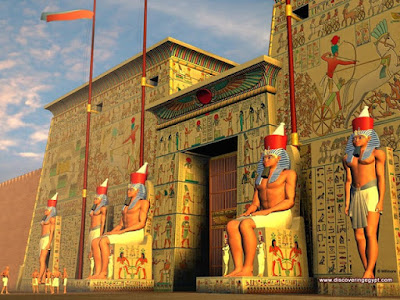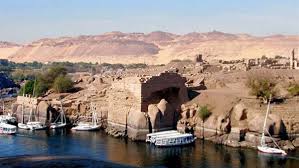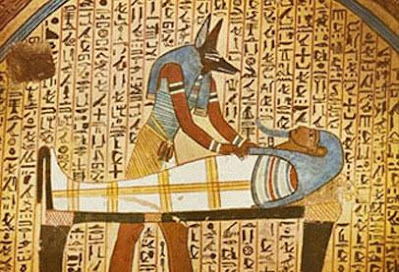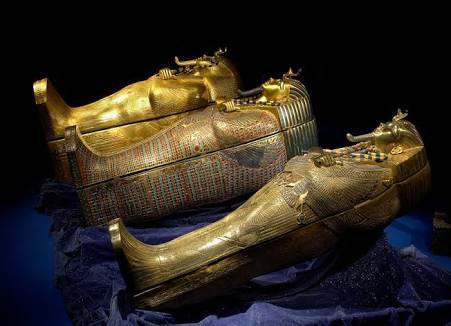The origins and development of ancient Egyptian religion
Throughout antiquity, the ancient Egyptian cared about the cause of this world
- How did it grow?
- Who created it?
- And what is the hidden force that controls it?
- How can this force be pleasing to avoid its evil and bring about its good?
* The ancient Egyptians believed in the doctrine of training and resurrection, but rather professed it and had a belief and theology of their own that preceded all religions by more than two thousand years. They preceded all civilizations of the world in this knowledge.
* The ancient Egyptian watched with deep thought all his components and guided him to several results to build his religion and beliefs: -
1- In this existence there are elements that control the creation directly or indirectly
2- Each of these elements guarantees a divine capacity that deserves sanctification and worship
3- These elements are related to each other and can be traced back to one ancient origin
* The ancient Egyptian reached the autobiography of the universe, and whoever arrives at this result must have known the owner of this universe that it did not come from an absolute vacuum.
Consequently, the struggle was most intense in the non-unification of these elements among the ancient Egyptian in one absolute theology expressed in order to preserve the political and religious prestige. Hence, the confusion came with Nabeul between myths and truth and superstitions.
Hence the names of the deities branched out among the first Egyptians, despite their belief that there is only one deity, and he will be held accountable on the Day of Judgment.
* The Egyptians began developing their ideas towards their heads, so they wrapped themselves up and began looking at the relationship of these elements and deities with the issue of creation with a philosophical view that goes beyond the physical understanding of the elements of existence beyond this perceived world; and their philosophical views differed on the origin of existence and the world as a result of different political and social conditions once or as a result of competition between their cities once Others
* The ancient cities and regions have begun to offer their interpretations of the existence of the universe according to their desire, goals, and vision of their priesthood. They are schools of theological beliefs that we may express this term.
For the fact that there is no doubt that each of these doctrines was launched from one of the Egyptian cities at the same time that they witnessed their political, civilizational, social and cultural prosperity.
* The Egyptian man began tending to interpret all aspects of the universe religiously, as they considered the one God incarnate in everything around them, so the Nile was considered the embodiment of the god (Nun), the sun is the god (Ra), the worshiped sky (Nut), and the worshiped earth (Jeb). He explained the sunrise and sunset as the journey of the god (Ra) the sun god, and that the eclipse and the eclipse are the obstacles facing this God, as the air was interpreted as the limbs of God (Amun)
These lords are called nitro (divine beings / cosmic powers)
After the pillars of the religion were completed in prehistoric times and through the doctrines of creation in the era of the families, these beliefs changed and developed according to the conditions that the country was going through from periods of weakness and transitional ages and on the contrary in periods of prosperity and prosperity, as merging between many of the gods
* From here, the idea of the old religion will be clear, so we may call it multiple doctrines and the original one. The doctrines of creation multiplied and spread in ancient Egypt. The most important of these doctrines are: -
1- Solar doctrine: -
This doctrine is attributed to the people of the city of On or the city of Heliopolis (the current Ain Shams) and is considered one of the oldest doctrines in existence and may return to prehistoric times in ancient Egyptian civilization and the owners of this doctrine believed in the emergence of existence and the beginning of creation that it was not in it A land, no sky, no humans, no beings, but a lack of an infinite water entity called it (Nun), and this water entity emerged in the spirit of my God, eternal, Creator is Atum and Atum is an Egyptian word that combines two meanings of meaning (meaning of nothingness and meaning Inclusiveness and completeness)
Atum appeared in his first great appearance with his oneness and found himself among the first two elements of existence, one of which was mentioned in the matter of space, air and light, and he was known as (Shu) and the other was a female who was charged with dampness and dew and was known as (Tafno) and the two divine elements mixed and interacted The rest of the great divine ninth was born from them, where two new elements appeared after them, one of which was mentioned in the matter of Jeb, and was known as Jeb, and the other was a female who commissioned the order of Heaven and was known as Nut, and heaven and earth were in their beginning connected to body and spirit until the permission of the Creator God to emerge from Between them the dawn of life, so it was revealed to Shu (the light and the air) to separate them, so the shu (the light and the air) lifted the sky from the earth and filled the space between it and the earth with what was surrounding it and emitting it from air and light
With this the presence is prepared for the existence of living beings and humans, so the creation was complete by the birth of the two previous gods. Four others are male, Osiris, who was sponsored in the earth by the matter of flood, fertility, and growth, and six who provided for the matter of the rains, thunder, and cyclones, and two females, each of whom was associated with her husband, Isis. Which was associated with Osiris and Nephthys, which were associated with Best, and with this the great divine ninth was completed, which is the origin of existence with all its worlds, living beings and inanimate objects
2- The Ashmuni school of thought:
Attributed to the current city of the Eshmunites, located in Middle Egypt, and was known in ancient time as Ono or Hermopolis, and these ancient names were converted to the Eshmunites
Their new doctrine revolves around the interpretation of the origin of existence in which they were fanatical to the eight elements of existence and called it the eighth and took from that the name of their new city where the number of eight was pronounced in the ancient Egyptian language Khumun and became in the Coptic language Shimon until the name developed in the Islamic era to the Ashmounin
As for the beginning of this interpretation, the new doctrine revolves around the controversy that abounded around the solar doctrine in different Egyptian cities, and to the attempt of the city's Ono rulers to advance their doctrine, and perhaps behind it are political reasons represented in a kind of political schism, they have declared war in politics, religion and thought at the same time One and these wise men tried at first to question some elements of the solar doctrine, asking among themselves whether Ra’s Atum had originally left Noun, as his followers said, so is it not considered a son of Nun, and if it is true, was it not supposed that Nun had two sides to bear children and what was Benon surrounds before his son gives birth, and did he have a real desire to do so, and after this skepticism and these questions, Ono’s thinkers had to present their own perception of existence and how the world originated, and they said that existence in its present form is presented by four elements which are (thick water and darkness surrounding and His motivating ability and a pleasant element he does not see) and they estimated that these four elements guarantee twins who agree in nature and differ in gender, one of which is male and the other is feminine and is the branch and that each of the twins provided a separate divine spirit and that is what made them eight
The first twins or first spirit overflowed in the beginning with a thick water ocean in which he settled and took a manifestation of his existence and called him with the name of Nun and a twin woman settled with him, deriving her name from his name, so they called her Taunt, then the third soul surrounded himself with thick darkness. He took a manifestation of his existence and settled in it and called with him In the name of Cook, and in the same way, a similar female settled, deriving her name from his name, so she named Kawkat, but the fifth spirit was represented in that driving force, whose owners derived the name of the doctrine from the word indicating the movement in the rush of waves or the flow of water, so they called it a monster, then assumed the presence of the female that is similar And derived its name from its name, so it was called Hawah, either the element or the seventh soul, it is that pleasant element that does not see any air and has named it by different names from it (grow, niao, wound and amon) and assumed a similar female and made its name derived from all previous names and The most famous name is Amount
And then they imagined that in the period when these eight elements or spirits, including male and female, gathered together and wanted to change what is in them from an old entity with another new entity, then they cooperated with each other to create a great sacrifice and put it on a high hill in the city of Ono and When the sacrifice split, a new creature came out of it, in fact it was not a matter of fact except the god Ra Atum, the god of light or the sun god that God who thought the owners of the solar doctrine that he found from nothing and since the emergence of God Ra Atum the world has become ready for the existence of beings and humans and thus we note that The difference between the solar doctrine and the Ashmunite gold is represented in two basic things. The first is the difference over the origin of the god Atum Ra, while the first gold holders believe that he found himself from the lack of belief in the owners of the second doctrine that he came after the eighth and through the cooperation of those spirits or the eight deities in creating The sacrifice that was split and the god came out
Secondly, it is represented in the difference about the basic elements of existence, while the solar doctrine came clear in the deification of the different elements of existence and an explanation of how each pair came from the previous husband and that everyone came thanks to God Atom as the Creator God, we find that the Ashmounian conception came ambiguous with regard to its name These four basic spirits and how to distinguish between a male and a female to the degree that they are born from them by dividing them into a male and a female that the eighth enemy who is the origin of God, and admiration of the second doctrine was confined to the private and intellectual circles
3- The Exile Doctrine: -
Attributed to the city of Memphis founded by King Mina, founder of the First Dynasty and the united Egypt. Memphis flourished in terms of culture and thought at that time and for its political status they tried to prove their superiority over the other cities, by saying that the temple of its god, God, Ptah, was the balance in which Upper and Lower Egypt was weighed. Perhaps that belief Returns to the middle place occupied by the city of Memphis since its founding, and there is no doubt that the starting point in this doctrine will start from two things
The first: upholding their city and its local bosses
The second is to contain the previous two doctrines by criticizing them one time and interpreting them again to become part of their own doctrine.
And the wise men of Mann had asked about that will that thought about creating the world and organizing its affairs, and that will must have been thought and contemplated before the order of creation itself was issued, and the thought and management must have preceded creation and development, and so the philosophers of Manaf reached the assumption of the existence of God Creator and that he included the universe and beings with his patronage and drawing of everything in the world of his ability and actions and based on the foregoing the exiles began describing God with new qualities that distinguish him from all lords in an unprecedented way so they considered it as the heart and tongue for them all and not the heart or the tongue in everything There is no doubt that the heart and the tongue have control over every body and the evidence is present in every chest and every mouth for both lords and humans and cattle and reptiles alike and if we asked them the strongest evidence of the validity of what they say they would say that what the eyes see and the ears hear and smell The nose rises all to the heart. As for the mouth, it is the mouthpiece of everything, as its philosophers say Mnf: Thus, it is originally a heart (or mind) that sent all the lords.
In this text, what confirms the discovery of the philosophers of Memphis confirms the importance of the word, especially the word of God or the divine word that is the origin of existence and the secret of the beginning of creation not only presented the idea itself, but presented it in a worthy way considering that the origin of existence in the eyes of philosophers of Memphis is the Creator God Ptah, but how was that The remarkable matter and consideration in their vision is that the god thought of his mind or his heart and then realized the creatures by nature of every creature and then uttered the word with his tongue so it was the fullness of the matter of creation, but with regard to the aspects included in the exiled text is not a matter of the interpretation of existence and the creation of the world, the most important aspect of it is that God It is he who has determined from the very beginning
And evil, and based on this determination, the destiny of human beings is decided. Whoever does good or whoever works in peace according to the text gives life to him, but whoever does evil and sins is not worthy of death and death.
4- Wasti school of thought: -
Attribution to the ancient city of West, which is currently the shortest, and which was known in ancient time as the name of any city of the scepter, and Greece has known it in the name of good, while the Arabs called it Luxor, and it has activated its philosophies to mix between the ancient doctrines of the origin of existence and how creation in a new way gave sovereignty to the god of their city The greatest god Amun and made her city or mother of cities and her lady
And he has portrayed his philosophers, West (Luxor), that they deserve to be the oldest and greatest of cities, and that they were the first to appear on the first hill that overlooked his head from water, meaning that they are the earth’s origin and the home of the first creation. The god of this city is the first and greatest god, and he is the creator of creation and the Lord of the worlds, and it is the beginning of existence, and this is what was expressed by the city philosophers in an important text in which they said (Amun was found from the beginning without knowing his origins, there was no god before him or there is a god with whom To describe to him a body, and he did not have a mother who devised a name for him or a son, to give birth to him, and to say here, and people said about him that he was (Tannin, Lord of Memphis), and that he was Amen, who was issued by Nun, and that he was one of the guidance of all creatures and that he has another form of the eighth members And it was he who created the first lords, and he was the one who completed himself in the form of Atum, and that he was in the beginning and wanted his philosophers and the old (shortest) philosophers to assure people that the divine spirit that they used to worship in temples and many did not in fact but one soul and that Their situation varied, they were all issued by one and bounced back to one
And this doctrine has remained the most common and common among the Egyptians and may be due to two main reasons
1- He summarized all the preceding doctrines and considered them to be from the heart of the Wasti school of thought, given that the god Amon was the first hidden and the last apparent one that united with the sun god and the god of the earths all.
2- He was the closest to the ancient Egyptians ’conception in that historical era. People in it still did not envision deism except in the form of multiple lords presided over by the Great God.
_______________
After we have listed the ancient philosophy of religion of the early Egyptians
There is no longer any room for doubt that the ancient Egyptians did not disbelieve or worship stones or idols like other civilizations that were in their time, but worshiped one God in his multiple forms.



































